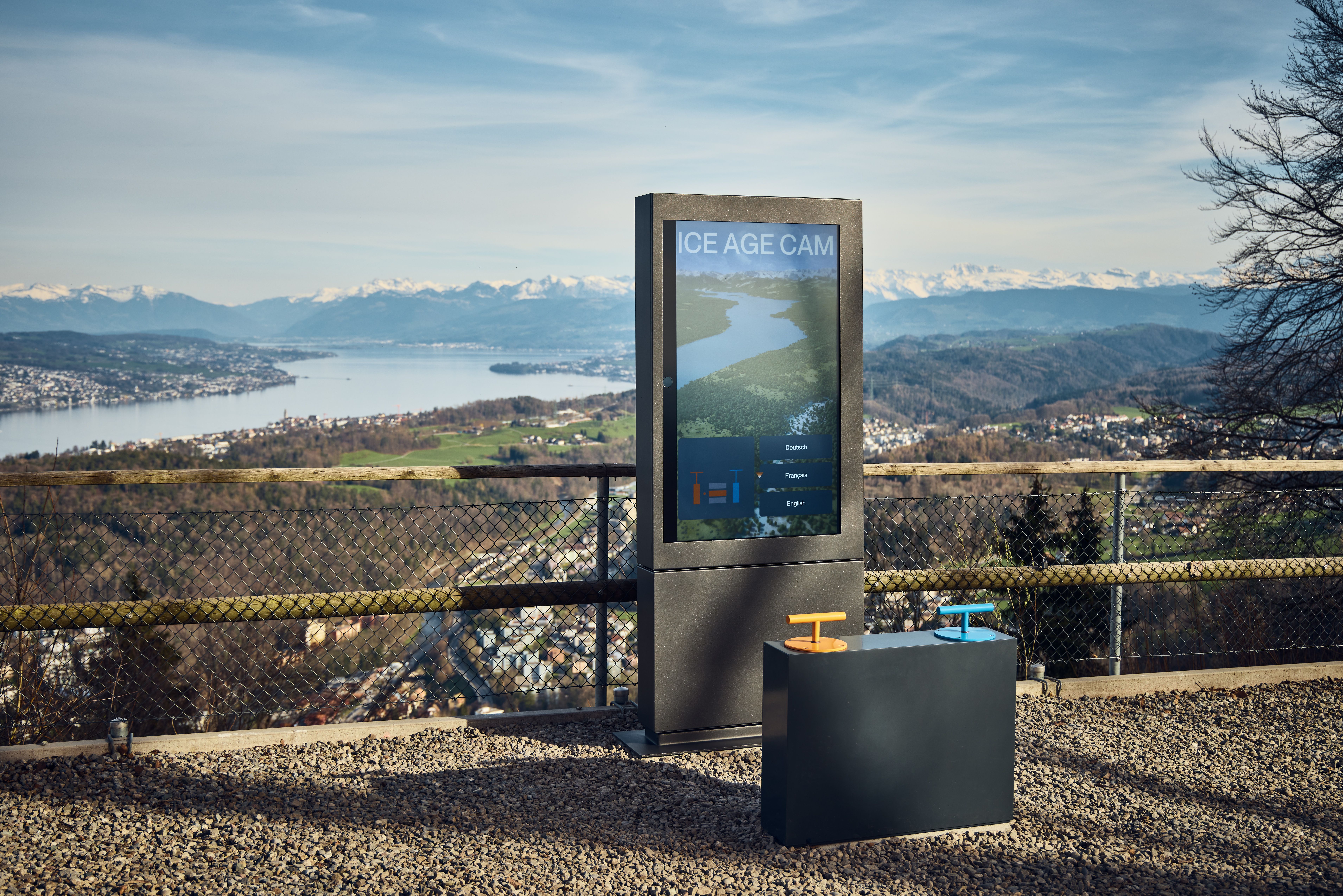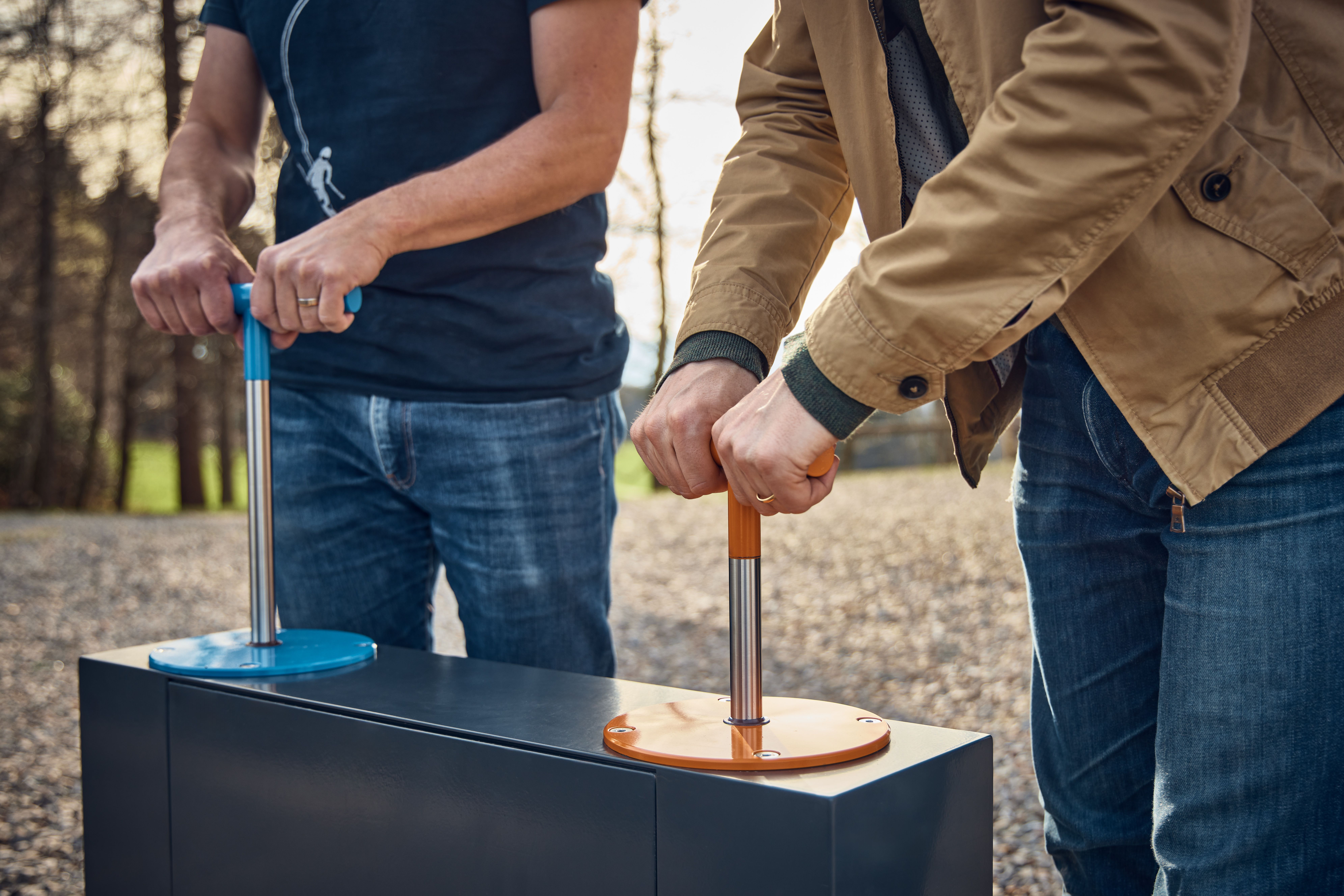A machine to counter preconceived ideas about ice ages and climate change
Scientists have developed a fun, interactive machine that demonstrates the human influence on climate change.
Posted on Mar 26, 2024Scientists from the University of Zurich, the University of Lausanne and the Zurich University of the Arts have developed a fun, interactive machine (IceAgeCam) that demonstrates the human influence on climate change. Inaugurated today at Felsenegg, a major tourist attraction in Zürich, it allows visitors to immerse themselves in the evolution of glacial landscapes.

The IceAgeCam on the terrace of the Felsenegg restaurant, with a panoramic view of Lake Zurich and the Alps in the distance. The IceAgeCam's pumps are used to modify the CO2 content of the atmosphere, thereby influencing the retreat and advance of glaciers. Periods of several hundred thousand years are playfully linked to current climate change. (Photos: Christian Grund, IceAgeCam)
Most people agree that human activities are causing an accelerated rise in temperatures, with the result that Alpine glaciers are retreating dramatically. Nevertheless, a number of sceptics try to play down this link, claiming that "temperature fluctuations have always existed", that "glaciers were once smaller than they are today" or that "the next ice age is inevitable".
Dispelling misunderstandings
This is where IceAgeCam comes in, an Agora project funded by the Swiss National Science Foundation (SNSF). This interactive installation aims to correct misconceptions about climate change in an entertaining way, and to point out the differences between natural temperature fluctuations, which extend over hundreds of thousands of years, and the dizzying rise in temperatures in recent decades. The machine was inaugurated today on the panoramic terrace of the Felsenegg restaurant, one of Zurich's top tourist attractions at an altitude of 800 metres, offering a panoramic view of Lake Zurich and the Alps.
It is the result of work by researchers from the Universities of Zurich (UZH), Lausanne (UNIL) and Zurich University of the Arts (ZHdK).

The IceAgeCam on the terrace of the Felsenegg restaurant, with a panoramic view of Lake Zurich and the Alps. The IceAgeCam's pumps are used to modify the CO2 content of the atmosphere, thereby influencing the retreat and advance of glaciers. Periods spanning several hundred thousand years are playfully linked to current climate change. (Photo credit: Christian Grund, IceAgeCam)
Predictions up to 2100
The IceAgeCam takes the form of a large screen flanked by two pumps. Players are tasked with following a timeline of past rates, pressing the pump handles to increase and decrease the proportion of greenhouse gases ( CO2) in the atmosphere.
As we all know, global temperatures are closely linked to the proportion of greenhouse gases (CO2) in the atmosphere. The game is therefore accompanied by a temperature curve, largely correlated with CO2 levels, and a simulated landscape in the real environment. By increasing or decreasing CO2 levels using pumps, users can see the changes in the landscape caused by the retreat or advance of glaciers over time. The Lake Zurich region, for example, was completely covered in ice during a cold period, then completely cleared of ice and revegetated again during a warm period. In contrast to these natural changes, the game illustrates the sharp rise in CO2 levels, caused by human activity, which are exceeding historical records. You can then take a selfie in front of the image and share it on Instagram.
The IceAgeCam uses scientific predictions to map possible future scenarios up to 2100. As well as the three-dimensional panoramic view, visitors can also watch a bird's-eye animation of the Alps during the last glacial cycle.

(Photo credit : Christian Grund, IceAgeCam)
Using AI to create images
IceAgeCam's simulations are based on research carried out by UZH's Department of Geography and the Institute for Land Surface Dynamics at the University of Lausanne. The model used simulates the interactions between climate and glaciological processes. To translate this data into visually impressive, high-resolution, satellite-like images, a team led by Guillaume Jouvet, glaciologist at the University of Lausanne, developed a generative deep-learning model. The design of the animation and the creation of the images were developed and implemented by ZHdK designers in the team led by Niklaus Heeb, who is responsible for knowledge visualisation.

Launch of the IceAgeCam
The IceAgeCam will be inaugurated at the Felsenegg restaurant on 26 March at 4.30pm.
Website
Instagram @iceagecam
An interdisciplinary SNSF project led by three Swiss universities
The IceAgeCam is an interdisciplinary collaborative project combining science, design and communication. It uses "scientainment" to attract a wide audience in an entertaining way and encourage dialogue.
The partners involved in the project are:
Department of Geography, University of Zurich
www.geo.uzh.ch
Andreas Linsbauer (andreas.linsbauer@geo.uzh.ch)
Institute of Earth Surface Dynamics, University of Lausanne
https://www.unil.ch/idyst/en/home.html
Guillaume Jouvet (guillaume.jouvet@unil.ch), Brandon Finley (Brandon.Finley@unil.ch)
Visualisation of Knowledge, Zurich University of the Arts
https://kvis.zhdk.ch/ Niklaus Heeb (niklaus.heeb@zhdk.ch), Jonas Christen (jonas.christen@zhdk.ch), Noemi Chow (noemi.chow@zhdk.ch)
Zurich Knowledge Center for Sustainable Development (ZKSD)
https://zksd.ch/projekt/iceagecam
Agora, Swiss National Science Foundation (SNSF)
https://www.snf.ch/en/JnT2xEAERCgO8qQc/funding/science-communication/agora
The research aspect of the project is based on the following research: Visualising the evolution of alpine glacier cover over the last 120,000 years